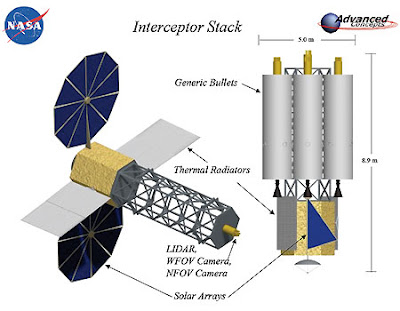Nuclear Asteroid Deflector
It's headed for an asteroid. It's got nuclear weapons. And it doesn't involve Bruce Willis. NASA scientists have proposed a spacecraft that would use atomic blasts to deflect asteroids on collision courses with Earth. Researchers from the Advanced Concepts Office at NASA's Marshall Space Flight Center in Huntsville, Ala., presented the idea at the 2007 Planetary Defense Conference, held in early March in Washington, D.C. The asteroid deflector would be launched from low Earth orbit by an Ares V rocket, NASA's next-generation heavy-cargo lifter, scheduled to go into service in 2020. As it approached the asteroid, the craft would at one-hour intervals release six missile-like interceptors, each tipped with a B83 one-megaton nuclear warhead. The warheads would detonate one by one near the surface of the asteroid, pushing it far enough off course so that it passes comfortably wide of Earth. Les Johnson, manager of interstellar propulsion research at the Marshall Center, took care to point out that the asteroid deflector is just an idea so far. "There's no blueprints. There's no funding," he said. "At this stage, it's just one of the many possible uses for the Ares V vehicle."
The asteroid deflector would be launched from low Earth orbit by an Ares V rocket, NASA's next-generation heavy-cargo lifter, scheduled to go into service in 2020. As it approached the asteroid, the craft would at one-hour intervals release six missile-like interceptors, each tipped with a B83 one-megaton nuclear warhead. The warheads would detonate one by one near the surface of the asteroid, pushing it far enough off course so that it passes comfortably wide of Earth. Les Johnson, manager of interstellar propulsion research at the Marshall Center, took care to point out that the asteroid deflector is just an idea so far. "There's no blueprints. There's no funding," he said. "At this stage, it's just one of the many possible uses for the Ares V vehicle." Nevertheless, the discovery of several potentially dangerous asteroids in recent years has prompted the space-science community to develop what it calls Near-Earth-Object Mitigation concepts — in other words, asteroid deflectors. Astronomers are specifically worried about 99942 Apophis, a 1,000-foot-wide asteroid discovered in 2004 that will come very close to Earth in 2029 — possibly hitting geostationary communications satellites — and might come even closer in 2036. In June 2002, another asteroid passed within 1/3 of the distance to the Moon, but was not discovered until three days later. Congress in 2005 charged NASA with cataloguing and analyzing 90 percent of all near-Earth objects by 2020.
Nevertheless, the discovery of several potentially dangerous asteroids in recent years has prompted the space-science community to develop what it calls Near-Earth-Object Mitigation concepts — in other words, asteroid deflectors. Astronomers are specifically worried about 99942 Apophis, a 1,000-foot-wide asteroid discovered in 2004 that will come very close to Earth in 2029 — possibly hitting geostationary communications satellites — and might come even closer in 2036. In June 2002, another asteroid passed within 1/3 of the distance to the Moon, but was not discovered until three days later. Congress in 2005 charged NASA with cataloguing and analyzing 90 percent of all near-Earth objects by 2020. Johnson stressed that the Marshall Center's proposal was not related to that law, which was incorporated into that year's NASA budget. The March presentation makes clear that nuclear-tipped interceptors would be a last resort, best used against solid asteroids within a short time frame before Earth impact. A "kinetic" interceptor, which would simply smash into the asteroid, would be better against smaller objects with a longer time frame. Best of all would be a solar collector, which would refocus solar light into a beam directed against the asteroid, slowly heating the surface to provide thrust — but that would require 10 years or more of lead time to be effective.
Johnson stressed that the Marshall Center's proposal was not related to that law, which was incorporated into that year's NASA budget. The March presentation makes clear that nuclear-tipped interceptors would be a last resort, best used against solid asteroids within a short time frame before Earth impact. A "kinetic" interceptor, which would simply smash into the asteroid, would be better against smaller objects with a longer time frame. Best of all would be a solar collector, which would refocus solar light into a beam directed against the asteroid, slowly heating the surface to provide thrust — but that would require 10 years or more of lead time to be effective.
 The asteroid deflector would be launched from low Earth orbit by an Ares V rocket, NASA's next-generation heavy-cargo lifter, scheduled to go into service in 2020. As it approached the asteroid, the craft would at one-hour intervals release six missile-like interceptors, each tipped with a B83 one-megaton nuclear warhead. The warheads would detonate one by one near the surface of the asteroid, pushing it far enough off course so that it passes comfortably wide of Earth. Les Johnson, manager of interstellar propulsion research at the Marshall Center, took care to point out that the asteroid deflector is just an idea so far. "There's no blueprints. There's no funding," he said. "At this stage, it's just one of the many possible uses for the Ares V vehicle."
The asteroid deflector would be launched from low Earth orbit by an Ares V rocket, NASA's next-generation heavy-cargo lifter, scheduled to go into service in 2020. As it approached the asteroid, the craft would at one-hour intervals release six missile-like interceptors, each tipped with a B83 one-megaton nuclear warhead. The warheads would detonate one by one near the surface of the asteroid, pushing it far enough off course so that it passes comfortably wide of Earth. Les Johnson, manager of interstellar propulsion research at the Marshall Center, took care to point out that the asteroid deflector is just an idea so far. "There's no blueprints. There's no funding," he said. "At this stage, it's just one of the many possible uses for the Ares V vehicle." Nevertheless, the discovery of several potentially dangerous asteroids in recent years has prompted the space-science community to develop what it calls Near-Earth-Object Mitigation concepts — in other words, asteroid deflectors. Astronomers are specifically worried about 99942 Apophis, a 1,000-foot-wide asteroid discovered in 2004 that will come very close to Earth in 2029 — possibly hitting geostationary communications satellites — and might come even closer in 2036. In June 2002, another asteroid passed within 1/3 of the distance to the Moon, but was not discovered until three days later. Congress in 2005 charged NASA with cataloguing and analyzing 90 percent of all near-Earth objects by 2020.
Nevertheless, the discovery of several potentially dangerous asteroids in recent years has prompted the space-science community to develop what it calls Near-Earth-Object Mitigation concepts — in other words, asteroid deflectors. Astronomers are specifically worried about 99942 Apophis, a 1,000-foot-wide asteroid discovered in 2004 that will come very close to Earth in 2029 — possibly hitting geostationary communications satellites — and might come even closer in 2036. In June 2002, another asteroid passed within 1/3 of the distance to the Moon, but was not discovered until three days later. Congress in 2005 charged NASA with cataloguing and analyzing 90 percent of all near-Earth objects by 2020. Johnson stressed that the Marshall Center's proposal was not related to that law, which was incorporated into that year's NASA budget. The March presentation makes clear that nuclear-tipped interceptors would be a last resort, best used against solid asteroids within a short time frame before Earth impact. A "kinetic" interceptor, which would simply smash into the asteroid, would be better against smaller objects with a longer time frame. Best of all would be a solar collector, which would refocus solar light into a beam directed against the asteroid, slowly heating the surface to provide thrust — but that would require 10 years or more of lead time to be effective.
Johnson stressed that the Marshall Center's proposal was not related to that law, which was incorporated into that year's NASA budget. The March presentation makes clear that nuclear-tipped interceptors would be a last resort, best used against solid asteroids within a short time frame before Earth impact. A "kinetic" interceptor, which would simply smash into the asteroid, would be better against smaller objects with a longer time frame. Best of all would be a solar collector, which would refocus solar light into a beam directed against the asteroid, slowly heating the surface to provide thrust — but that would require 10 years or more of lead time to be effective.
































<< Home